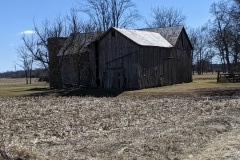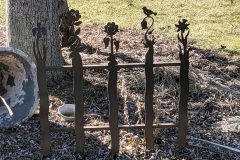Back at it after an Ohio winter-induced delay to keep our fingers and toes from freezing off! Today’s feature image shows us proudly displaying our ‘Little Loop’ patches we received during the winter layoff! This put a little more spring in our step at the beginning of our hike (although sadly, or perhaps expectedly, this wore off after a few miles…). Once again was a minor chore to find a place to park the ‘finish’ car, but we did manage to find a skeptical but eventual willing farmer to share some parking space near his storage barn. After getting permission, April and I went and parked our car up the road a little ways at the barn and waited for Wendy to come pick us up for our drive back to the starting point to meet up with Robin…only Wendy never came? Turned out that Wendy had already headed back to meet Robin at the starting point without us! A phone call was needed to remind Wendy about our usual transport plan, which we have been doing for two years now… Wendy must have been extra antsy to get going (although you would never know it by how long it takes her to gear up for hiking). That may have been the highlight (or lowlight?) of the trip, besides hiking past a nice little log cabin on a pond that was almost perfect for my ‘On Golden Pond’ homesteading desires. Hike today was all road, but at least we avoided muddy trails from all the snow melt. Still a lot of Trump flags waving out here, just wonder if/when they will come down…maybe not until 2024? The long layoff from hiking had April and I dragging in the end, so the only remedy is to keep on at it!
We decided to add a new section: blog burner questions that arise from keen observations we make along our hike. Todays two questions are: 1) why are barns painted red? and 2) why did that farmer only grow his corn crop to half its size, with cobs still on the stalks, and leave it uncut over the winter? 3) How much do farmers make anyway? FEEL free to enlighten us in the comments section below! If not, we will rely on Robin as our newly appointed Sherlock Holmes stand-in to provide an answer.
Sherlock Answers: 1) New England settlers didn’t have enough money to paint their farms. So they needed a cheap way to protect the barns’ wood. They mixed skimmed milk, lime, and red iron oxide to make a red, plastic-like coating. The coating protected the wood and kept barns warmer in the winter. When paint became more available, many people chose red paint for their barns in honor of tradition.
2) The corn in the field is not necessarily dying, but drying. By drying out the liquid starch (milk stage), the corn can be harvested and used for all the necessities you and I need! From glue to corn flakes, cattle feed to fuel, corn (the dented field corn) is not only a complement to our society, but also a crucial source to create so many things. Without corn, a nation would simply not be born!
3) The lower 10 percent of farm professionals make less than $35,020, and the top 10 percent receive earnings of more than $126,070. The average farmer salary varies depending on how well the crops do and changes in operational costs for farmers.
50% of the 1600 farmers and ranchers polled said that they typically worked between 10 and 14 hours daily. Nearly 20% said that they worked about 15 hours a day.
If you love farming, it’s worth it, but it’s not a get rich quick scheme. Farmers don’t make millions, although they do average around $70,000 a year. The other problem with farming is that it’s hard to get started. Until you pay off your investment, you don’t get to keep much of that income.
Using projected average yields of 198 bu. corn and 59 bu. soybeans per acre, farms averaged $673 total revenue per acre and averaged $664 total cost per acre. The most profitable farm made $275 per acre while the least profitable lost $222 per acre.






















